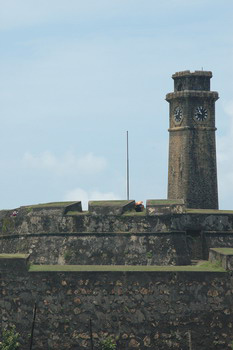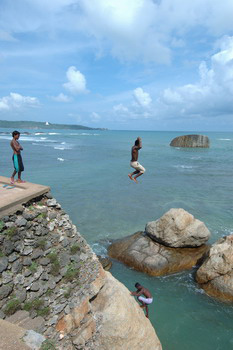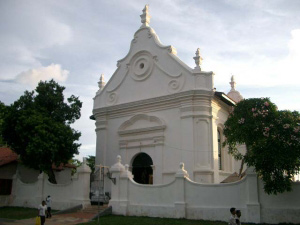
| Home |
| Where is Fort Galle? |
| Galle City |
| Galle Fort |
| Travelling Around |
| Places to See |
| Best Places to Stay |
| Shopping |
| 2004 Tsunami |
| Galle, Sri Lanka Today |
| Useful Resources |
| Resources |
Places to See Within The Galle Fort
 First-time visitors to the Galle Fort are certain to fall in love with and be enthralled by the walled city's romantic old-world atmosphere. Preserved through the years since the Dutch occupation, Galle is a showcase of the impressive intermingling of Dutch culture with South Asian tradition. This intermingling is clearly evident in the city's major sights and structures, most of which are still functioning to this day — a fact recognized by the UNESCO when it declared Galle a World Heritage Site in 1988.
First-time visitors to the Galle Fort are certain to fall in love with and be enthralled by the walled city's romantic old-world atmosphere. Preserved through the years since the Dutch occupation, Galle is a showcase of the impressive intermingling of Dutch culture with South Asian tradition. This intermingling is clearly evident in the city's major sights and structures, most of which are still functioning to this day — a fact recognized by the UNESCO when it declared Galle a World Heritage Site in 1988.
These amazing tourism spots within the city of Galle are must-sees for visitors who want to understand the unique character of this enduring port city and of the island of Sri Lanka as a whole.
The Dutch Fort, which is another name by which Galle Fort is called to emphasize the fact that although it was the Portuguese who erected it, it was the Dutch who expanded it and strengthened its defense system, is a 36-hectare sanctuary that carries a unique air of tranquility and history. Protected from the rest of the island and encircled by a continuous rampart that is broken only by 14 massive bastions, the working Galle Fort houses a number of museums, a clock tower, places of worship, a lighthouse and over a hundred residences including hotels, guest houses and restaurants. It is interesting to note that unfounded fear of invasion by the Sinhalese kings has moved the Dutch colonizers to spend a great deal of labor and wealth on three major ramparts — the Star Bastion, the Moon Bastion, and the Sun Bastion — stretching across the peninsula from west to east successfully isolating it from the mainland. While these fortifications may seem quite impregnable to the armies of Kandy and Colombo, in present-day Galle Fort, the angular crevices provided by these bastions no longer provide protection from arrows but privacy for courting couples, especially at dusk.
Although it's possible to walk around the fort in two hours, a day is recommended to thoroughly enjoy all the magnificent sights and structures the fort has to offer.
The first such interesting sight to greet tourists would be the British-built Clock Tower located within the Main Gate. From here, the stroll leads to the various museums located within the fort.
 The Dutch Museum on Leyn Baan is one must-see for visitors. Housed in a restored Dutch mansion, this privately-owned museum provides a glimpse into the activities of the Dutch East India Company and contains paintings, prints, documents, furniture and various artifacts from the colonial era ranging from rare porcelain to obscure bric-a-brac. Other museums in the area, which suffer in comparison to the Dutch Museum, include the National Maritime Museum on Queen Street. This tiny museum is located in the Old Gatehouse, a massively fortified Dutch warehouse that is of even greater interest than the maritime artifacts and memorabilia it houses. The National Cultural Museum on Church Street is another small museum that houses a relatively small poorly displayed collection of the city's colonial heritage. Most agree that by itself the Galle Fort is a far more interesting 'living museum' compared to the museums it houses.
The Dutch Museum on Leyn Baan is one must-see for visitors. Housed in a restored Dutch mansion, this privately-owned museum provides a glimpse into the activities of the Dutch East India Company and contains paintings, prints, documents, furniture and various artifacts from the colonial era ranging from rare porcelain to obscure bric-a-brac. Other museums in the area, which suffer in comparison to the Dutch Museum, include the National Maritime Museum on Queen Street. This tiny museum is located in the Old Gatehouse, a massively fortified Dutch warehouse that is of even greater interest than the maritime artifacts and memorabilia it houses. The National Cultural Museum on Church Street is another small museum that houses a relatively small poorly displayed collection of the city's colonial heritage. Most agree that by itself the Galle Fort is a far more interesting 'living museum' compared to the museums it houses.
Far more fascinating than the museums is the run-down Groote Kerk or "Great Church" on Church Street. The structure that houses this Great Church was built in 1640 by the Portuguese but the building that houses it at present was constructed by the Dutch and founded in 1754 by the then Dutch Governor of Galle, Capar de Jong. The seat of the Dutch Reformed Church, Groote Kerk is a must-see for the ancient Dutch gravestones in the churchyard and within the nave. Skulls and skeletons mark these gravestones giving one an idea of the unstable nature of life in 18th century Galle and the dourness of contemporary Dutch Protestantism.
On the opposite side of Groote Kerk stands the Dutch Government House, an excellently built old colonial building that bears the cockerel crest of Galle over its main entrance and which carries the date 1683. It is said that there are plans to convert this building into a hotel although there are doubts as to whether this plan will succeed since the house is believed to be haunted.

Other places of worship along Church Street include the British-constructed Catholic All Saints Church consecrated in 1871 and the two Muslim mosques, the more impressive of which is the Meera Masjid.
Close to the Groote Kerk stands the Amangalla. Formerly used as headquarters for the Dutch commander and later as quarters for British troops, this hotel was established in 1865, one of 12 at the time within the fort, during the period when Galle was the major port of the island. As a working hotel, Amangalla has been in business for over 140 years.